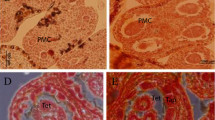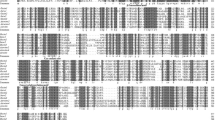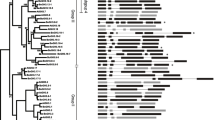Abstract
Sesamum indicum is widely cultivated in India for its superior agronomic characters like adaptation to the warm climate of India and resistance to drought and pathogen attack. However, the yield of sesame per unit area of land is quite low. In this context, the genes involved with reproductive tissue development is very important since they are directly involved with crop productivity. Therefore, identification and isolation of anther-specific genes through PCR-Select cDNA subtraction between cDNAs of anthers and leaves was carried out. Sequencing of ~ 700 clones from the cDNA subtraction library followed by BLASTX analysis using sesame database resulted in the identification of 163 annotated unique transcripts, of which 18 transcripts showed homology with the genes of exclusive anther-/pollen-specific functions. Furthermore, anther-specific expression of some of the sesame transcripts as well as already identified anther-specific genes of Arabidopsis and rice have been monitored during development of sesame anthers. Subsequently, full-length cDNA sequence and the upstream sequence of an anther-specific β-1 3-glucanase gene was isolated. Transgenic tobacco plants were developed with GUS gene under the control of a 437-bp upstream sequence along with the first exon and first intron of the gene. Monitoring of GUS gene expression pattern indicated exclusive expression of the promoter in the tapetal cell layer before tetrad formation in the anther. Interestingly, upon treatment with ABA as well as drought stress, GUS was found to express in the vegetative parts of the plant such as leaves and roots as well.









Similar content being viewed by others
Abbreviations
- ABA :
-
Abscisic acid
- bp:
-
Base pair
- PMC:
-
Pollen mother cells
- CDS`:
-
Coding DNA sequence
- cDNA:
-
Complementary deoxyribonucleic acid
- kb:
-
Kilobase
- MS:
-
Murashige and Skoog
- PDB:
-
Protein data bank
- PCR:
-
Polymerase chain reaction
- RNase A:
-
Ribonuclease A
- RT-PCR:
-
Reverse transcription polymerase chain reaction
- T1:
-
First-generation transgenic line
References
Abou-Gharbia HA, Shahidi F, Adel A, Shehata Y, Youssef MM (1997) Effects of processing on oxidative stability of sesame oil extracted from intact and dehulled seeds. J Am Oil Chem Soc 74(3):215–221. https://doi.org/10.1007/s11746-997-0126-9
Ali GM, Yasumoto S, Katsuta M (2007) Assessment of genetic diversity in sesame (Sesamum indicum L.) detected by amplified fragment length polymorphism (AFLP) markers. Electron J Biotechnol 10(1):0–0. https://doi.org/10.2225/vol10-issue1-fulltext-16
Biabani AR, Pakniyat H (2008) Evaluation of seed yield-related characters in sesame (Sesamum indicum L.) using factor and path analysis. Pak J Biol Sci 11(8):1157–1160. https://doi.org/10.3923/pjbs.2008.1157.1160
Bino RJ (1985) Histological aspects of microsporogenesis in fertile, cytoplasmic male sterile and restored fertilePetunia hybrida. Theoret Appl. Genetics 69(4):423–428. https://doi.org/10.1007/BF00570912
Bray EA (2004) Genes commonly regulated by water-deficit stress in Arabidopsis thaliana. J Exp Bot 55(407):2331–2341
Bucciaglia PA, Zimmermann E, Smith AG (2003) Functional analysis of a β-1,3-glucanase gene (Tag 1) with anther-specific RNA and protein accumulation using antisense RNA inhibition. J Plant Physiol 160(11):1367–1373. https://doi.org/10.1078/0176-1617-01207
Chatterjee M, Mazumder M, Basu D (2013) Functional analysis of the promoter of a glycosyl hydrolase gene induced in resistant Sinapis alba by Alternaria brassicicola. Phytopathology 103(8):841–850. https://doi.org/10.1094/PHYTO-11-12-0303-R
Chaudhury A (1993) Nuclear genes controlling male fertility. Plant Cell 5(10):1277–1283. https://doi.org/10.1105/tpc.5.10.1277
Clancy M, Hannah LC (2002) Splicing of the maize Sh1 first intron is essential for enhancement of gene expression, and a T-rich motif increases expression without affecting splicing. Plant Physiol 130(2):918–929. https://doi.org/10.1104/pp.008235
Creelman RA, Mullet JE (1997) Biosynthesis and action of jasmonates in plants. Annu Rev Plant Physiol Plant Mol Biol 48(1):355–381. https://doi.org/10.1146/annurev.arplant.48.1.355
Cui X, Wang Q, Yin W, Xu H, Wilson ZA, Wei C, Pan S, Zhang D (2012) PMRD: a curated database for genes and mutants involved in plant male reproduction. BMC Plant Biol 12(1):215. https://doi.org/10.1186/1471-2229-12-215
Deyholos MK, Sieburth LE (2000) Separable whorl-specific expression and negative regulation by enhancer elements within the AGAMOUS second intron. Plant Cell 12(10):1799–1810. https://doi.org/10.1105/tpc.12.10.1799
Dickinson HG, Lewis D (1973) The formation of the tryphine coating the pollen grains of Raphanus, and its properties relating to the self-incompatibility system. Proc R Soc London Ser B Biol Sci 184(1075):149–165. https://doi.org/10.1098/rspb.1973.0040
Doxey AC, Yaish MWF, Moffatt BA, Griffith M, McConkey BJ (2007) Functional divergence in the Arabidopsis beta-1,3-glucanase gene family inferred by phylogenetic reconstruction of expression states. Mol Biol Evol 24(4):1045–1055. https://doi.org/10.1093/molbev/msm024
Frankel R, Izhar S, Nitsan J (1969) Timing of callase activity and cytoplasmic male sterility in petunia. Biochem Genet 3(5):451–455. https://doi.org/10.1007/BF00485605
Garai AK, Datta JK (1999) Influence of plant growth regulators on growth, morpho-physiological characters and yield of summer sesame (Sesamum indicum L. cv. Rama) under moisture stress. Acta Physiol Plant 21(3):277–281. https://doi.org/10.1007/s11738-999-0043-7
Glass M, Barkwill S, Unda F, Mansfield S (2015) Endo-β-1,4-glucanases impact plant cell wall development by influencing cellulose crystallization. J Integr Plant Biol 57(4):396–410. https://doi.org/10.1111/jipb.12353
Goldberg RB (1993) Anther development: basic principles and practical applications. Plant Cell 5(10):1217–1229. https://doi.org/10.1105/tpc.5.10.1217
Grant I, Beversdorf WD, Peterson RL (1986) A comparative light and electron microscopic study of microspore and tapetal development in male fertile and cytoplasmic male sterile oilseed rape (Brassica napus). Can J Bot 64(5):1055–1068. https://doi.org/10.1139/b86-144
Heslop-Harrison J (1968) Pollen wall development. Science 161(3838):230–237. https://doi.org/10.1126/science.161.3838.230
Horner HT Jr, Rogers MA (1974) A comparative light and electron microscopic study of microsporogenesis in male-fertile and cytoplasmic male-sterile pepper (Capsicum annuum). Can J Bot 52(3):435–441. https://doi.org/10.1139/b74-056
Horsch R (1985) A simple and general method for transferring genes into plants. Science 227(4691):1229–1231. https://doi.org/10.1126/science.227.4691.1229
Huang G, Liu X, Liu L, Ye F, Zhang M, Shu Y (2008) Comprehensive evaluation of multiple cropping systems on upland red soil. Front Biol China 3(3):344–350. https://doi.org/10.1007/s11515-008-0047-5
Izhar S, Frankel R (1971) Mechanism of male sterility in petunia: the relationship between pH, callase activity in the anthers, and the breakdown of the microsporogenesis. Theoret Appl Genetics 41(3):104–108. https://doi.org/10.1007/BF00277751
Jin W, Horner HT, Palmer RG (1997) Genetics and cytology of a new genic male-sterile soybean [Glycine max (L.) Merr.] Sex Plant Reprod 10(1):13–21. https://doi.org/10.1007/s004970050062
Kadkhodaie A, Razmjoo J, Zahedi M, Pessarakli M (2014) Selecting sesame genotypes for drought tolerance based on some physiochemical traits. Agron J 106(1):111. https://doi.org/10.2134/agronj2013.0260
Kandasamy MK, Nasrallah JB, Nasrallah ME (1994) Pollen-pistil interactions and developmental regulation of pollen tube growth in Arabidopsis. Development 120:3405–3418
Kessler A, Baldwin IT (2001) Defensive function of herbivore-induced plant volatile emissions in nature. Science 291(5511):2141–2144. https://doi.org/10.1126/science.291.5511.2141
Koltunow AM, Truettner J, Cox KH, Wallroth M, Goldberg RB (1990) Different temporal and spatial gene expression patterns occur during anther development. Plant Cell 2(12):1201–1224. https://doi.org/10.1105/tpc.2.12.1201
Lee KH, Piao HL, Kim H-Y, Choi SM, Jiang F, Hartung W, Hwang I, Kwak JM, Lee I-J, Hwang I (2006) Activation of glucosidase via stress-induced polymerization rapidly increases active pools of abscisic acid. Cell 126(6):1109–1120. https://doi.org/10.1016/j.cell.2006.07.034
Leubner-Metzger G, Meins F (2000) Sense transformation reveals a novel role for class I β-1,3-glucanase in tobacco seed germination. Plant J 23(2):215–221. https://doi.org/10.1046/j.1365-313x.2000.00773.x
Mariani C, Beuckeleer MD, Truettner J, Leemans J, Goldberg RB (1990) Induction of male sterility in plants by a chimaeric ribonuclease gene. Nature 347(6295):737–741. https://doi.org/10.1038/347737a0
Mepham RH, Lane GR (1970) Observations on the fine structure of developing microspores ofTradescantia bracteata. Protoplasma 70(1):1–20. https://doi.org/10.1007/BF01276839
Morris, J.B., 2002. Food, industrial, nutraceutical, and pharmaceutical uses of sesame genetic resources. Trends in new crops and new uses 153–156
Mun J-H, Lee S-Y, Yu H-J, Jeong Y-M, Shin M-Y, Kim H, Lee I, Kim S-G (2002) Petunia actin-depolymerizing factor is mainly accumulated in vascular tissue and its gene expression is enhanced by the first intron. Gene 292(1-2):233–243. https://doi.org/10.1016/S0378-1119(02)00646-7
Rao VP, Rao SP (1981) Chemical composition and fatty acid profile of high yielding varieties of oilseeds. Indian J Agric Sci 51:703–707
Romero I, Fernandez-Caballero C, Goñi O, Escribano MI, Merodio C, Sanchez-Ballesta MT (2008) Functionality of a class I beta-1,3-glucanase from skin of table grapes berries. Plant Sci 174(6):641–648. https://doi.org/10.1016/j.plantsci.2008.03.019
Rose AB (2002) Requirements for intron-mediated enhancement of gene expression in Arabidopsis. RNA 8(11):1444–1453. https://doi.org/10.1017/S1355838202020551
Roy N, Abdullah S, Jahan MS (2009) Yield performance of sesame (Sesamum indicum L.) varieties at varying levels of row spacing. Res J Agric Biol Sci 5:823–827
Samman S, Chow JWY, Foster MJ, Ahmad ZI, Phuyal JL, Petocz P (2008) Fatty acid composition of edible oils derived from certified organic and conventional agricultural methods. Food Chem 109(3):670–674. https://doi.org/10.1016/j.foodchem.2007.12.067
Schrauwen J a M, Mettenmeyer T, Croes AF, Wullems GJ (1996) Tapetum-specific genes: what role do they play in male gametophyte development? Acta Botanica Neerlandica 45(1):1–15. https://doi.org/10.1111/j.1438-8677.1996.tb00491.x
Scott R, Hodge R, Paul W, Draper J (1991) The molecular biology of anther differentiation. Plant Sci 80(1-2):167–191. https://doi.org/10.1016/0168-9452(91)90281-C
Sheldon CC, Conn AB, Dennis ES, Peacock WJ (2002) Different regulatory regions are required for the vernalization-induced repression of flowering locus C and for the epigenetic maintenance of repression. Plant Cell 14(10):2527–2537. https://doi.org/10.1105/tpc.004564
Shi Y, Zhao S, Yao J (2009) Premature tapetum degeneration: a major cause of abortive pollen development in photoperiod sensitive genic male sterility in rice. J Integr Plant Biol 51(8):774–781. https://doi.org/10.1111/j.1744-7909.2009.00849.x
Stieglitz H (1977) Role of beta-1,3-glucanase in postmeiotic microspore release. Dev Biol 57(1):87–97. https://doi.org/10.1016/0012-1606(77)90356-6
Wang W, Bianchi L, Scali M, Liu L, Bini L, Cresti M (2009) Proteomic analysis of β-1,3-glucanase in grape berry tissues. Acta Physiol Plant 31(3):597–604. https://doi.org/10.1007/s11738-008-0269-9
Warmke HE, Overman MA (1972) Cytoplasmic male sterility in sorghum. I. Callose behavior in fertile and sterile anthers. J Hered 63(3):103–108. https://doi.org/10.1093/oxfordjournals.jhered.a108244
Yaish MWF, Doxey AC, McConkey BJ, Moffatt BA, Griffith M (2006) Cold-active winter rye glucanases with ice-binding capacity. Plant Physiol 141(4):1459–1472. https://doi.org/10.1104/pp.106.081935
Acknowledgements
The authors are indebted to the Director, Bose Institute, Kolkata, for providing the necessary facilities for carrying out our research. We are grateful to University Grants Commission for providing fellowship to the author. We are also indebted to Department of Biotechnology, Government of India, for funding in the form of project.
Author information
Authors and Affiliations
Contributions
The study was conceived, planned, and executed by SP, MM, and DB. All experimental works were carried out at different stages of the study by SP, SM, AB, BM, MM, US, AM, and AD. Time to time technical guidance, whenever necessary, was offered by DB, MM, and SP. The manuscript was edited and prepared by SP, MM, and DB. All authors read and approved the final manuscript prepared for submission by SP, MM, and DB.
Corresponding author
Ethics declarations
Conflict of Interest
The authors declare that they have no conflict of interest.
Electronic Supplementary Material
Supplementary Figure S1
Agarose gel profile of the subtracted cDNA population and its validation: (A) The cDNA obtained from the anthers of sesame buds was subtracted from that of the leaves following the protocol provided with the PCR-Select cDNA Subtraction Kit from Clontech. Lane 1 shows the 500 bp ladder, Lane 2 shows the test sample (subtracted cDNAs, lane 3 shows the unsubtracted control cDNA, and lane 4 shows the 100 bp ladder. (B) The subtracted cDNA population was then purification using QIAGEN purification kit. Further, the purified cDNA was alcohol precipitated and then run on a 1% Agarose gel to check the quality. Lane 1 shows the 100 bp ladder; Lane 2 shows the purified subtracted cDNA population. (C) The subtracted and unsubtracted libraries were checked for the expression of the GAPDH gene. Reduction in the expression of GAPDH in the subtracted population is an evidence of successful subtraction. Lanes 1&5 depict 18 cycles of PCR for the subtracted and unsubtracted libraries respectively. Similarly, lanes 2&6, 3&7 and 4&8 depict 23, 28 and 33 cycles of either libraries as shown. For the unsubtracted cDNA library, the expression of GADPH is strong between 18 and 33 PCR cycles. However, the expression of the same is markedly low in the subtracted cDNA population even after 33 cycles, whereas no expression is seen in from 18 to 28 PCR cycles. Thus, it is apparent that proper and efficient subtraction has taken place. C.No. Stands for a number of cycles. (PDF 629 kb)
Supplementary Figure S2
Expression pattern of the 17 selected transcripts in the different tissues of sesame: RT-PCR data showing the amplification of 12 out of 17 transcripts in anther tissue, whereas no comparable amplification of the same was detected in other tissues of the plant in the gel. GAPDH is taken as internal control. (JPEG 1249 kb)
Supplementary Figure S3
Isolation of full-length β-1,3-glucanase (BISI27f) gene by 5′ RACE and its upstream sequence: (A) Full-length β-1,3-glucanase (SiBG) gene was isolated through 5’RACE. An 813 bp long EST sequence was obtained after the cDNA subtraction which had significant homology with the Nicotiana tabecum β-1,3-glucanase gene. (B) The isolated fragment was incorporated into a TA clone and sequenced. Primers were designed from it’s 5′ region, and then 5’RACE genome walking procedure was performed to isolate the upstream sequence of the SiBG gene. A 512 nt sequence of the upstream element was isolated from the genome walking. (C) Further 5′ walking was performed in a similar way which resulted in a total of 712 nt long upstream sequences. (PDF 458 kb)
Supplementary Figure S4
(a) Schematic representation of the isolation of upstream and 1st intron nucleotide sequence of β-1,3-glucanase (BISI27f) gene through cDNA subtraction followed by 5′ RACE and PCR mediated genome walking. (b) Schematic representation of the construct containing the 437 bp upstream sequence, first exon, first intron and the fusion sequence of the sesame β 1,3-glucanase gene with the GUS reporter gene. (PPTX 51 kb)
Supplementary Figure S5
Restriction analysis of the SiBGpro-GUS cloned in the plant expression vector called pPZPY112. A. Lanes 1 & 3 show digestion of clones with the enzymes HindIII and EcoRI which gives a pop-out at the size of around 2.8 kb which corresponded with the size of the desired cassette. Lanes 2 & 4 show digestion of clones with the enzymes HindIII and BamHI which gives a pop-out of around 670 kb which corresponds to the size of the SiBGpro which was cloned between these given sites. Lane 5 is the 1 kb plus ladder. The clones were also checked for the presence of the SiBGpro sequence and that of the kanamycin resistance gene by using the specific primers in a PCR reaction. B. Lanes 1–4 show the amplicon of the promoter sequence (437 bp) in the clones and lanes 5–8 show the presence of the kanamycin resistance gene (~500 bp). (PDF 340 kb)
Supplementary Figure S6
Induction pattern of SiBG gene upon ABA and drought treatment in sesame leaves: 4 weeks old sesame plants were treated with 20 μM ABA for 6 h and 20% PEG for 48 h each. The control plants were treated only with water. In control samples (Lane 1), there was no amplification of the β-1,3-glucanase (SiBG), whereas the ABA treated (Lane 2) and the PEG treated (Lane 3) plants showed a distinct induction of the same. GAPDH was taken as the internal control in both the cases. (JPEG 148 kb)
Supplementary Figure S7
Splicing of the first intron of the gene in anthers and upon ABA and drought treatment of leaves. (a) Amplification of the SiBG gene sequence along with the first intron through RT-PCR using GUS gene specific reverse primer and SiBG gene specific 5’end forward primer (NBG-f) from the total cDNA of transgenic Nicotiana tabecum plants, treated with ABA/dehydration stress. Lane 1 shows amplification using genomic DNA which results in a band of a larger size (100 bp larger). Lanes 2 and 3 show amplification in anther cDNAs of stages II and III. Lanes 4, 5 and 6 show amplification from the cDNAs of leaves treated with ABA at 10 μM, 20 μM and 30 μM concentrations. Lane 7 showed control without stress. Lanes 8, 9 and 10 show amplification from cDNAs of leaves exposed to drought stress (days 3, 5 and 7 respectively). (b) In sesame also we have tested the expression of β-1,3-glucanase (SiBG) on external application of ABA at a concentration of 10 μM, 20 μM and 30 μM as well as exposing sesame plants under drought for 7 days. Lane 1 shows amplification using genomic DNA which results in a band of a larger size (100 bp larger). Lanes 2 and 3 show amplification in anther cDNAs of stages II and III. Lanes 4, 5 and 6 show amplification from the cDNAs of leaves treated with ABA at 10 μM, 20 μM and 30 μM concentrations. Lane 7 showed control without stress. Lanes 8, 9 and 10 show amplification from cDNAs of leaves exposed to drought stress (days 3, 5 and 7 respectively). In both the cases, RT-PCR analysis of the ABA/drought treated sesame cDNA using the primers NBG-f (+1 bp to +21 bp) and NBG-r (+132 bp to +150 bp) designed from 5’region of the gene showed induction of the gene. NBG-f – AGCTGTCGACAAGCTTCGACGGCCCGGGCTGGTAAC. NBG-r- AGCTGGATCCAGCACCTGCCAGTGAAAACC. GUS r- CAATTGCCCGGCTTTCTTGTAAC (PDF 629 kb) (PNG 81 kb)
Supplementary Table S1
(DOCX 49 kb)
Supplementary Table S2
(DOCX 15 kb)
Rights and permissions
About this article
Cite this article
Parveen, S., Mazumder, M., Bhattacharya, A. et al. Identification of Anther-Specific Genes from Sesame and Functional Assessment of the Upstream Region of a Tapetum-Specific β-1,3-glucanase Gene. Plant Mol Biol Rep 36, 149–161 (2018). https://doi.org/10.1007/s11105-017-1054-y
Published:
Issue Date:
DOI: https://doi.org/10.1007/s11105-017-1054-y




